| 1 | Found in stifling, humid swamps |
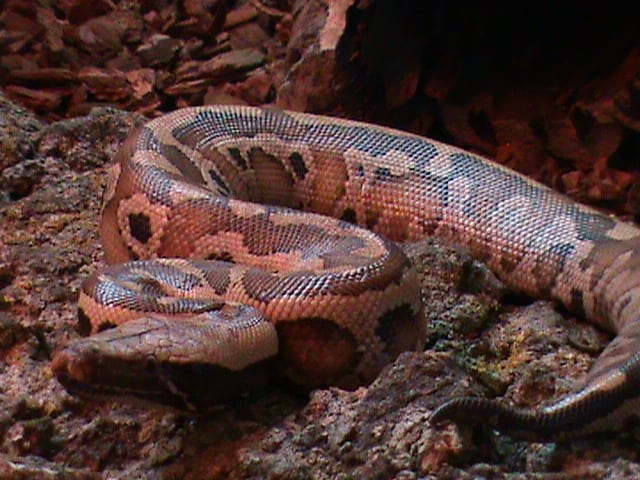
Indonesia, Malaysia and southern Thailand are home to the reticulated python, the longest snake in the world. However, they’re also home to a cooler customer, which prefers to wait in deep forests and not pointlessly break into supermarkets: the blood python.
This snake is a popular captive species with reptile enthusiasts, and lives up to its name with deep red patches. It’s a natural inhabitant not just of forests, but boggy, humid swamps within forests, where it waits on the muddy outskirts for prey. Blood pythons are sometimes found lurking underwater, occasionally up trees, but their main life involves waiting for days in ambush, occasionally shifting position, sometimes covered with fallen mulchy leaves.
There’s two sides to the blood python coin. They can deliver an extremely powerful bite, with front fangs designed for gripping prey, then constricting. However, their strike distance is very short, and it’s more likely to land a few inches from your shoe. No matter how dead a blood python looks, it is always alert. Its small eyes are always locked onto your every move, even if they’re still as a statue on the shores of their disease-infested swamp.
| 2 | Ultra-thick and crushing |
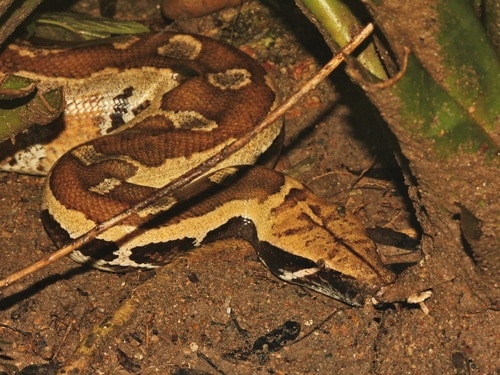
The blood python is a medium length python. Its record length was 240cm, and adult males typically range from 91 to 152cm. Females are significantly longer at 120-180cm. However, the gimmick of this species isn’t length, but how thick they are.
The blood python may have the highest length to width ratio of any snake. The blood python looks permanently obese, and if it really was obese, it would be a monster. In comparison to its body, its head looks tiny.
In reality, the round “fat” is pure muscle, and the blood python has freakish strength. When picked up by a snake enthusiast, it is able to wriggle free with ease. All constrictors have muscular bodies for squeezing their prey, but when evolution was happening, the blood python didn’t know when to stop. Blood pythons have a very long and flat head, and their tail is extremely short, like it’s been overwhelmed by their bloated body.
| 3 | The famous blood patterns |
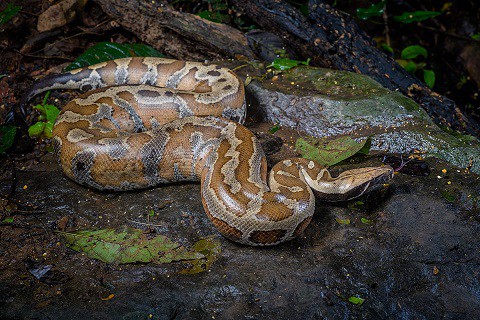
Blood pythons have multiple colour phases in the wild. They vary from a dull rusty red, to the properly bright “blood” red. Their tongue is normally almost black, but some morphs can have pink tongues.
The weirdest thing is the blood python’s ability to change head colour. Its head shifts from black to red to grey, with some keepers believing the redness increases as they get excited. First time keepers might be stunned to walk in on a very different blood python to that morning.
Usually in snakes, hatchlings are more fabulously colourful. Blood pythons are the reverse, as the famous blood colouring reaches its peak at 4 years old and stays intense thereafter. At birth, hatchlings are brown, grey or orange.
Some blood python morphs can look very painful. They look like a grey snake whose scales have been scraped away to leave multiple patches of raw, bleeding skin below. Their belly is a completely contrast, usually white with very small black markings.
| 4 | A popular captive python |
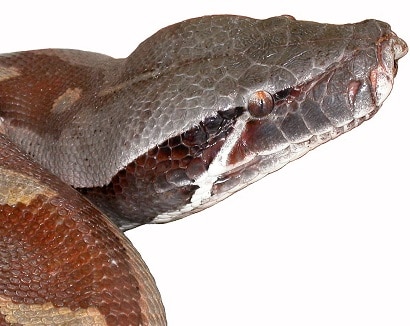
The blood python is one of the most popular pet snakes worldwide, owing to their vibrant colours and naturally lazy lifestyle. Many morphs are available, including one with the black spots on their bellies closer together. There’s an albino morph, and of course the normal blood red morph. Another is the matrix, which has larger white patches, while keeping some red, and an intricate pixelated pattern. Breeding a matrix with a normal will result in 50% of the hatchlings being matrix.
Then there’s the ivory blood python. This is a result of breeding two matrix (usually 25% of hatchlings will be ivory), and has barely any blood red, instead an elegant marble white like a sculpture.
One strange phenomenon in captivity involves their personalities. Until the 1980s, the blood python had a reputation as one of the most vicious captive snakes, refusing to calm down no matter how much you soothed them. This viciousness could last for years. However, almost all blood pythons back then were imported from Malaysia. When the primary exporter switched to Indonesia, the blood pythons mysteriously became calmer. They snapped at first, but were likely to grow accustomed to their masters.
Nowadays, most pets are born in captivity from mothers captured in the wild, and then exported overseas. Despite being part of the same species, blood pythons in Malaysia and Indonesia seem to have a naturally different temperament.
| 5 | Attracted to palm oil plantations |

Palm oil is one of the biggest environmental bogeymen being debated today. Swathes of rainforest are cut down to create palm oil plantations in southeast Asia, reducing habitat for endangered orangutans, Sumatran rhinos, and pygmy elephants. The carbon-rich peat soil below is exposed, and releases CO2 into the atmosphere.
Making matters worse, the palm oil trade is rife with slavery and wage exploitation. But one animal has benefited – the blood python. Despite their love of swamps and marshes, blood pythons are attracted to these plantations, and the rodents within are enough to live on. They can be more common in these plantations than the surrounding forests.
Experts believe that thanks to palm oil, blood pythons are more common than ever, despite the pressure from skinning and exports. They sometimes have ready made houses, as blood pythons scoop out the bottom of termite mounds and rest there without permission. It’s not just palm oil, as blood pythons also congregate in rubber plantations without being invited.
| 6 | The Indonesian harvest trade |
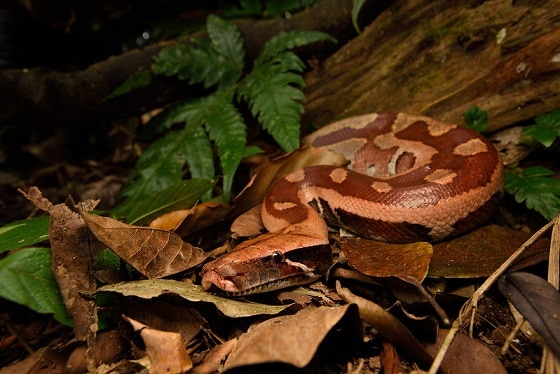
Nobody is sure whether blood pythons are falling or not. They’re far from endangered, but combined with their short-tailed python relative, it’s estimated that 60,000 are harvested from the Indonesian wilds each year.
North Sumatra is the head of this booming industry, which has been active since the 1980s. The massive influx of blood pythons into palm oil plantations has made things easier, as harvesters just turn up with a torch and bag. The blood pythons are then brought to slaughterhouses, which operate on an industrial scale. The skins are prized for luxury fashion, destined for snake leather used in wallets and shoes. Unlike the oriental ratsnake, which ends up in Chinese soup and medicine, the main customer for blood python skins is western nations. In 2011 alone, the EU imported 31126 skins, with Italy being the top importer.
A 2022 study investigated whether the Indonesian blood python industry was sustainable. Its verdict was big red stamp of “uncertain”. It cited 9 local blood python harvesters, 7 of whom believed that their numbers were falling in the wild. It referenced a 2012 study, which found that blood python catches per area had fallen, which was only compensated by adding more harvest areas.
| 7 | Are they in danger? |
The blood python industry is regulated by a quota system, for different regions within Indonesia. For example, the North Sumatra quota for skins was 21,090 in 2008, and 20,000 in 2021. There’s also a separate quota for live blood pythons for the pet trade, which was 1500 both in 2008 and 2021.
The 2022 study found that suppliers had invented crafty methods to dodge these quotas. One batch was labelled as coming from Laos, which raised eyebrows, given that blood pythons don’t exist in Laos. It’s believed that in tough quota years, dodgy exporters will simply label wild caught blood pythons as captive bred, which face no restrictions. One study even found that wild blood pythons were becoming thinner, probably because the large ones were being caught.
Road development is also a factor. In 1995, for example, 56% of Sumatra’s roads were 80% paved. By 2005, this had risen to 71%, and the pace has continued since then. This made travelling 50km a big hassle in the old days, but now, blood python harvesters have more freedom to scour the land.
| 8 | Diet: a rodent buffet |
The majority of pythons rely on mammals, and the blood python is no different. However, they seem even more specific than some. While reticulated pythons graduate to monkeys or pigs as adults, blood pythons eat rodents almost exclusively, in their palm oil plantation hangouts.
In captivity, they also accept rabbits greedily, and a standard recommendation is one rat per week, or maybe two for a large adult. They’re not ultra fussy, as captive blood pythons happily accept dead rodents, whether freshly killed or thawed. This is partly why they’re so popular in captivity. If the blood python has rats and a few square metres, it’s happy.
In a study on 5 pythons, the blood python had the slowest digestive rate. 2 days after eating a rodent meal, 59% remained intact in its stomach, slower than the Burmese python (48%), ball python (56%), reticulated python (34%) and African rock python (42%). Interestingly, the ball python and blood python share a short stumpy body, whereas the 3 longer pythons digested food faster.
| 9 | Most active at dawn and dusk |
Blood pythons aren’t encountered much by Thai tourists, but not because they’re uncommon. They live in dengue fever infested swamps with 2 feet of rotting leaf litter, where glimpses of a black head are the only indication that something venomous could be nearby. Not surprisingly, nobody goes near those places; vast caves and the glitz of Bangkok are higher on the list.
Compared to reticulated pythons, the blood python is a pure ambush predator. They almost never go on the prowl, instead waiting patiently by their stifling, humid bogs for days at a time. In swamps, its the undisputed master, so why would it leave? When a rodent walks past, the blood python performs a basic lunge, and grips the prey with its sharp front fangs.
Blood pythons are most active around dawn and dusk (crepescular). They have a long lifespan, often reaching 20 years in captivity. They lay eggs, and have a high count of up to 30. It’s rare to find this species at high altitude; the limit is 650 metres.
| 10 | Actually 4 separate species |
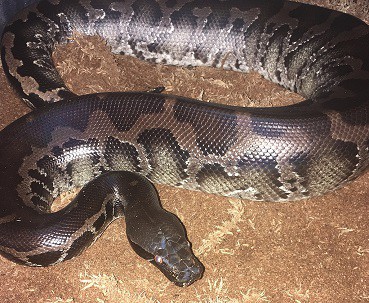
The world has ten “true” species of python, which fall into the official Python family. 4 are in Africa, and southeast Asia hosts a subgroup with a similar short, monstrously thick body. Until 2000, these were all lumped into one species: the short-tailed python (Python curtus). This snake lives in southwestern Sumatra and offshore islands, and also has swampy habitats, but its colours are duller.
In 1938, the blood python was designated as a short-tail subspecies, Python curtus brongersmai, owing to its redness. Then came the full species elevation in 2000, and a third family member, Python breitensteini, was separated from Python curtus in 2001. This lives solely on the island of Borneo.
In 2002, yet another new member was found: the rare Myanmar short-tailed python, known from a handful of individuals. The four form a subgroup within the python family, and blood pythons have by far the largest range, spanning Indonesia, Malaysia, southern Thailand and many islands.
It turns out that blood pythons are easily the most genetically distinct of the three more common members. A study found an 8.9% divergence in mitochondrial DNA from the short-tailed python, which isn’t significantly less than the reticulated python at 10.3%. Meanwhile, Python breitensteini and P. curtus had only a 3% divergence.
